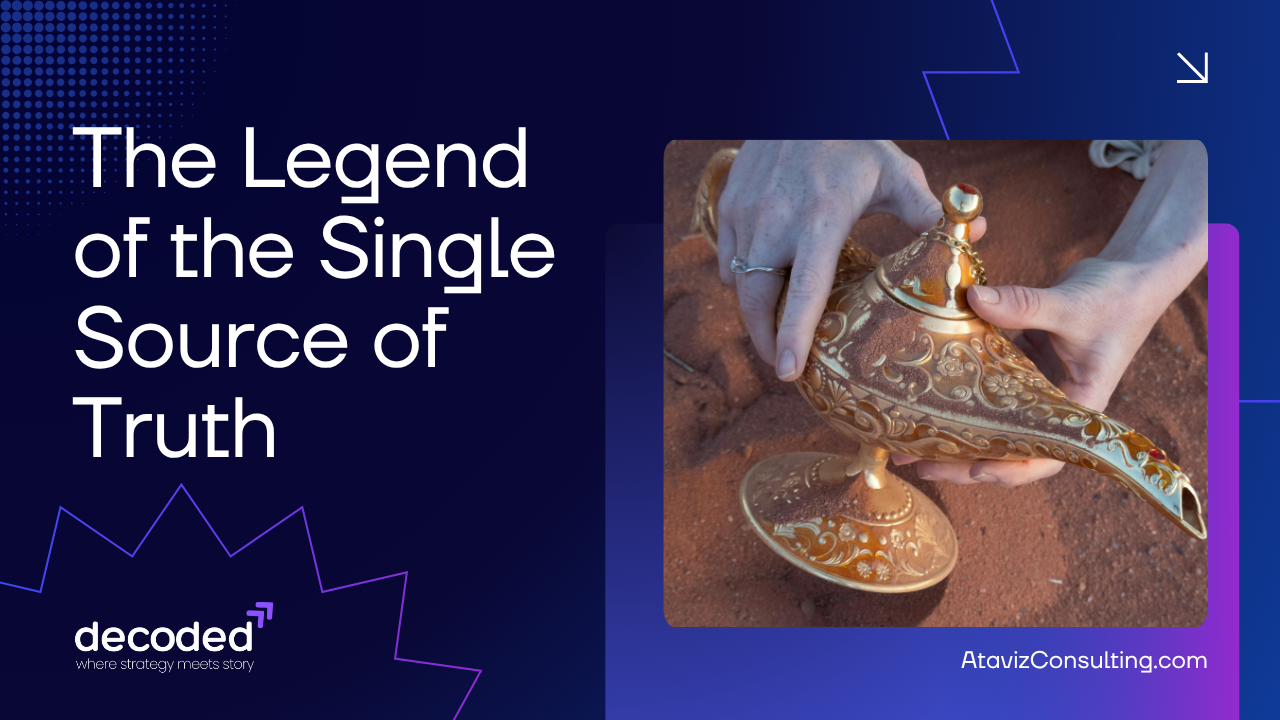
The Legend of
The Single Source of Truth

July 16, 2025
By Nicholas Johnson, Founder of Ataviz Consulting
You’ve heard it in boardrooms, pitch decks, and staff meetings:
“We just need a single source of truth.”
It sounds so simple. So elegant. So… solvable.
Until you actually try to build one.
From Startups to Federal Agencies-Same Dream, Same Struggle

Over the last decade, I’ve helped build and audit data systems for scrappy startups, mission-driven nonprofits, and sprawling federal agencies.
Different missions. Different tech stacks. Different levels of resourcing.
Same problem.
Each one was buried under layers of spreadsheets, CRMs, ad hoc reports, and siloed platforms—each clinging to its version of the truth.
Sales had one number. Finance had another. Marketing had three.
And the execs? They just wanted something anything they could trust.
The Problem Isn’t Just Dirty Data, It’s Dirty Context

Everyone talks about data cleanliness: duplicates, mismatched fields, nulls, outdated entries.
Yes, those are problems.
But the bigger issue? Inconsistent context.
- One team logs “leads” as anyone who downloads a whitepaper.
- Another defines them as qualified prospects with a sales touch.
- The dashboard says 3,000 leads this month. Which version is that?
This is the semantic gap, and it’s what turns clean rows into confusing reports.
You can normalize formats. You can standardize timestamps. But if your org hasn’t aligned on what the data means, then you’re just polishing chaos.
The Politics of Truth

Here’s the part no one likes to admit:
The fight for a single source of truth is often a political one.
Why?
Because defining “truth” means choosing whose version of reality wins.
- Do we trust Salesforce or the fundraising spreadsheet?
- Do we measure success by revenue or impact?
- Whose KPIs make it onto the dashboard?
Data isn’t just technical, it’s organizational identity. It’s priorities. It’s power.
And when those aren’t aligned, no amount of ETL is going to fix it.
So, What Do You Actually Do?

Let’s not be cynical. A single source of truth is achievable, but it’s not a tool. It’s a discipline.
Here’s how I guide organizations toward it:
1. Start With Alignment, Not Architecture
Before you build anything, ask:
“What are the 3–5 key metrics we need to make decisions, and what do we mean by each one?”
If teams can’t agree, no tech stack will save you.
2. Don’t Try to Boil the Ocean
You don’t need every field from every system. Start with the high-leverage datasets. Get those clean, aligned, and trustworthy.
Truth is earned one layer at a time.
3. Assign Owners, Not Just Tools
Every core metric or data stream needs a human owner. Someone who knows what it means, where it lives, and when to update it.
Accountability beats automation.
4. Accept That Truth Has Versions
Sometimes the best path isn’t forcing everything into one table. It’s surfacing context-specific truths, and labeling them clearly.
Ex: "Marketing Qualified Leads (MQLs) per HubSpot logic" versus "Sales-Qualified Leads per CRM tagging."
You can live with multiple truths—as long as you’re honest about which one you’re using.
Truth Isn’t a Database—It’s a Culture

Here’s what I’ve learned, after years of wrestling messy data into usable form:
A single source of truth isn’t built—it’s earned.
It comes from shared definitions, consistent ownership, and a willingness to challenge assumptions. It’s technical, yes, but also operational, political, and cultural.
So if your dashboards still feel like a guessing game, don’t just audit your pipelines. Audit your alignment.
If this hit home, or if your team is still arguing over the “real” revenue number, send this their way. It might be time for a truth summit.
-- Your Hidden CTO

Stay in the loop
Get updates straight to your inbox.